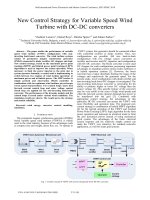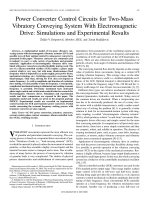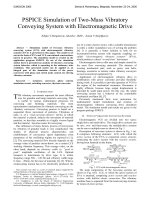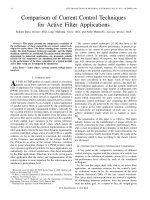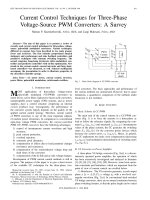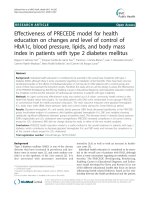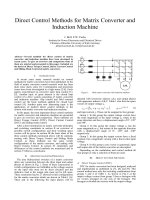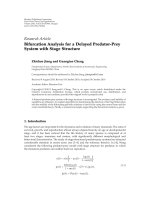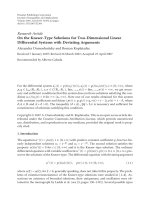Power converter control circuits for two mass vibratory conveying system with electromagnetic drive simulations and experimental results IEEE trans
Bạn đang xem bản rút gọn của tài liệu. Xem và tải ngay bản đầy đủ của tài liệu tại đây (873.96 KB, 14 trang )
IEEE TRANSACTIONS ON INDUSTRIAL ELECTRONICS, VOL. 54, NO. 1, FEBRUARY 2007 453
Power Converter Control Circuits for Two-Mass
Vibratory Conveying System With Electromagnetic
Drive: Simulations and Experimental Results
ˇ
Zeljko V. Despotovic
´
, Member, IEEE, and Zoran Stojiljkovic
´
Abstract—A mathematical model of two-mass vibratory con-
veying system with electromagnetic vibratory actuator (EVA) and
possible ways of their optimal control by using power converter is
presented in this paper. Vibratory conveyors are commonly used
in industry to carry a wide variety of particulate and granular
materials. Application of electromagnetic vibratory drive com-
bined with power converters provides flexibility during work. The
use of a silicon-controlled rectifier (SCR) implies a phase angle
control, which is very easy, but with many disadvantages (fixed
frequency which is imposed by ac mains supply, poor power factor,
mechanical retuning, etc.). Switching converters overcomes these
disadvantages. Only then, driving for EVA does not depend on
mains frequency. As well as amplitude and duration of excitation
force tuning, it is also possible to tune its frequency. Consequently,
complicated mechanical tuning is eliminated and seeking resonant
frequency is provided. Previously mentioned facts motivated
phase angle control and switch mode control behavior research for
electromagnetic vibratory drives. Simulation and experimental
results and their comparisons are exposed in this paper. The
simulation model and results are given in the program package
PSPICE. Experimental results are recorded on implemented
control systems for SCR and transistor power converters. Partial
results concerning the resonant frequency seeking process with
transistor converter are also exposed.
Index Terms—AC–DC power conversion, actuators, conveyors,
current control, phase control, resonance, silicon-controlled recti-
fier (SCR), switching circuits.
I. I
NTRODUCTION
V
IBRATORY movements represent the most efficient way
of granular and particulate materials conveying. The con-
veying process is based on a sequential throw movement of par-
ticles. Vibrations of tank, i.e., “load-carrying element” (LCE),
in which the material is placed, induce the movement of material
particles, so that they resemble a highly viscous liquid, and the
material becomes easier to transport and to dose. Due to influ-
ences of many factors, the process of conveyance by vibration
of granular loads is very complicated. The studies of physical
process characteristics and establishment of conveyance speed
Manuscript received November 3, 2004; revised April 20, 2006. Abstract pub-
lished on the Internet November 30, 2006. This work was supported by the Ser-
bian Ministry of Science and Environmental Protection.
ˇ
Z. V. Despotovic
´
is with the Mechatronics Laboratory, Mihajlo Pupin
Institute, 11000 Belgrade, Serbia and Montenegro (e-mail:
bg.ac.yu; ).
Z. Stojiljkovic
´
is with the Department of Electrical Engineering, Laboratory
of Power Converters, University of Belgrade, 11000 Belgrade, Serbia and Mon-
tenegro (e-mail: ).
Digital Object Identifier 10.1109/TIE.2006.888798
dependence from parameters of the oscillating regime are ex-
posed in [1]–[4]. These parameters are frequency and amplitude
oscillations of LCE and waveform of the LCE kinematics tra-
jectory. There are also references that consider dependence of
particles velocity from angle of vibration and inclination of the
LCE [5], [6].
The conveying material flow directly depends on the average
value of particles throw movements, being on a certain LCE
working vibration frequency. This average value, on the other
hand, depends on
vibratory width, i.e., doubled amplitude oscil-
lation, of the LCE. Optimal transport is determinated by drive
type. It is within the frequency range 5 Hz–120 Hz and the vi-
bratory width range 0.1 mm–20 mm, for most materials [1], [7].
Different drive types can achieve mechanical vibrations of
the conveying element. The very first drives were originally me-
chanical (pneumatics, hydraulics, and inertial). Today, most of
the common drives are electrical. When a reciprocating mo-
tion has to be electrically produced, the use of a rotary elec-
tric motor with a suitable transmission is really a rather round-
about way of solving the problem [8]. It is generally a better
solution to look for an incremental-motion system with mag-
netic coupling, so-called “electromagnetic vibratory actuator”
(EVA), which produces a direct “to-and-from” movement. Elec-
tromagnetic drives offer easy and simple control for the mass
flow conveying materials. In comparison to all previously men-
tioned drives, these have a more simple construction and they
are compact, robust, and reliable in operation. The absence of
wearing mechanical parts, such as gears, cams belts, bearings,
eccentrics, or motors, makes vibratory conveyors and vibratory
feeders most economical equipment [9]–[13].
Application of electromagnetic vibratory drive in combina-
tion with the power converter provides flexibility during work.
It is possible to provide operation of the vibratory conveying
system (VCS) in the region of the mechanical resonance. Res-
onance is highly efficient, because large output displacement is
provided by small input power. In this way, the whole conveying
system has a behavior of the controllable mechanical oscillator
[14], [15].
Silicon-controlled rectifier (SCR) converters are used for the
EVA standard power output stage. Their usage implies a phase
angle control [14]–[16] in full-wave and half-wave modes.
Varying firing angle provides the controlled ac or dc injection
current to control mechanical oscillations amplitude, but not the
tuning of their frequency. Since conventional SCR controller
operates at a fixed frequency, the vibratory mechanism must
be retuned. Another way of producing a sine full-wave (or
0278-0046/$25.00 © 2007 IEEE
454 IEEE TRANSACTIONS ON INDUSTRIAL ELECTRONICS, VOL. 54, NO. 1, FEBRUARY 2007
Fig. 1. Constructions of the conventional EVA. (a) Inductor on reactive side. (b) Inductor on active side.
Fig. 2. Simplified EVA presentations. (a) Inductor on reactive side. (b) Inductor
on active side.
half-wave) injection current is to use switch-mode power con-
verters. Only then, driving for EVA does not depend on mains
frequency. It is possible to adjust the frequency, amplitude, and
duration of EVA coil current, i.e., frequency and pulse intensity
of the excitation force, to be applied on the LCE.
Change of the mechanical resonant frequency, due to change
of the conveying material mass, or even change of the spring
stiffness, reduces efficiency of vibratory drive. An optimal and
efficient operation requires tracking of resonant frequency.
Consequently, complicated mechanical tuning is eliminated
and electronics replace mechanical settings [17].
Previously mentioned facts were motivation for mathemat-
ical model formulation and for further research of both the
phase angle control and switch mode control behavior for the
electromagnetic vibratory conveying drive. Simulations and
experimental results and their comparisons are exposed in
this paper. The simulation model and results are given in the
program package PSPICE. Experimental results are recorded
on the implemented control systems for SCR and transistor
power converters.
II. E
LECTROMAGNETIC
V
IBRATORY
A
CTUATOR
(EVA)
All main types of vibratory actuators can be seen as two-mass
systems. The majority of them generate harmonic excitation
forces, while some types generate transmitting impact pulses.
The EVA can be single- or double-stroke construction. In the
single-stroke type, there is an electromagnet, whose armature is
attracted in one direction, while the reverse stroke is completed
by restoring elastic forces. In the two-stroke type, two electro-
magnets, which alternately attract the armature in different di-
rections, are used.
In Fig. 1, two of the most common single-stroke constructions
are shown. One of them has armature on its active side, while
Fig. 3. EVA presentation for analysis. (a) Electromechanical model. (b) Equiv-
alent mechanical model at
t =0
.
the inductor is on its reactive side, as shown in Fig. 1(a). The
other construction is set vice versa, as shown in Fig. 1(b).
Simplified constructions of the above-mentioned vibratory
actuators are shown in Fig. 2.
The mathematical model of EVA is based on presentation in
Figs. 2(a) and 3 with details. An electromagnet is connected to
an ac source and the reactive section is mounted on an elastic
system of springs. During each half period when the maximum
value of the current is reached, the armature is attracted, and at
a small current value it is repelled as a result of the restoring
elastic forces in springs. Therefore, vibratory frequency is
double frequency of the power supply. These reactive vibrators
can also operate on interrupted pulsating (dc) current. Their
frequency in this case depends on the pulse frequency of the
dc. A mechanical force, which is a consequence of this current
and created by electromechanical conversion in the EVA, is
transmitted through the springs to the LCE.
It is assumed that the mass of load
is much greater than
the mass
of a movable reactive section. Let us suppose that
springs are identically constructed, with stiffness
and pre-
stressed with action adjustable force
. This force is used for
setting the air gap value in the actuator. The nonlinearity of
spring elements is neglected. Total equivalent damping coeffi-
cient of system springs is
. The movement of the inductor is
restricted in the
-direction. At (initial moment), grav-
itational force is compensated by spring forces (
, ), as in
Fig. 3(b).
It is supposed that the ferromagnetic material has a very high
permeability
(the reluctance of the magnetic core path can
be ignored) compared to
of the air gap and bronze disk. Con-
sequently, all the energy of the magnetic field is stored in the air
gap and bronze. The area of cross section of the air gap is
.
DESPOTOVIC
´
AND STOJILJKOVIC
´
: POWER CONVERTER CONTROL CIRCUITS FOR TWO-MASS VCS 455
The air gap length in the state of static equilibrium is . The
bronze disk with thickness
does not permit the inductor to
form a complete magnetic circuit of iron; in other words, it in-
hibits “gluing” of the inductor, which is undesirable. Fringing
and leakage at the air gap can be neglected too. In order to re-
duce eddy currents loss, the magnetic core is laminated. Also,
the magnetic circuit operation in the linear region of
mag-
netization curve, with adequate limitation of the current value,
is assumed. Excitation coils are connected to the voltage source
. The source has its own resistance , while the excitation
coils (hereafter termed “coil”) have their own resistance
. The
current in the
-turns excitation coil is noted as .
Ampere’s law for the reference direction of path
, as shown
in Fig. 3(a), will be applied according to the following equation:
(1)
with
–magnetic intensity in air gap and –magnetic inten-
sity in bronze. The flux density is
(2)
Substituting this expression into (1), the flux density is
(3)
The flux in bronze and air gap is
(4)
The total flux is
(5)
The state function of the magnetic coenergy is
(6)
The solution of this integral is
(7)
The total system coenergy is
(8)
Equation (7) can be usefully shown as
(9)
where constant
is
(10)
The function of the system potential energy can be shown as
(11)
where the state function of the electrical energy is zero, because
there is no accumulative electrostatic energy in the system.
Based on the previous equations, Lagrange’s function state for
the EVA can be written as
(12)
Rayleigh’s dissipate function is defined by the following rela-
tion:
(13)
A dynamical equation of motion for mechanical subsystem
with usage of Lagrange’s equation can be presented as
(14)
where external action
is the gravitational force ( ).
From (12)–(14), the equation of motion for a mechanical sub-
system becomes
(15)
The term on the right side of the (15) presents electromag-
netic excitation force
. This force is the function of the coil
current
and displacement . A dynamical equation of motion
for electromagnetic subsystem is obtained in a similar way de-
riving from
(16)
where external electrical action is
. From (12), (13),
and (16), the equation of electromagnetic subsystem becomes
(17)
The first term of (17) is voltage that has been induced from
current change in the circuit of the coil. Inductance of the cir-
cuit is the function of the inductor’s position. The second term
presents voltage drop on the equivalent resistance. The third
term is actually induced electromotive force, which is a con-
sequence of exertion of the mechanical subsystem on the elec-
tromagnetic subsystem.
Equations (15) and (17) describe the motion and electrical
behavior of the EVA.
III. M
ATHEMATICAL
M
ODEL OF THE
VCS
Electromagnetic VCSs are divided into two types:
single-drive and multidrive. The single-drive systems can
be one-, two-, and three-mass; the multiple-drive systems
can be one- or multiple-mass [1]. A description of one type
single-drive two-mass electromagnetic vibratory conveyor
is shown in Fig. 4(a). Its main components are the LCE, to
which the active section of the EVA is attached, comprising
an active section and reactive section, with built-in elastic
456 IEEE TRANSACTIONS ON INDUSTRIAL ELECTRONICS, VOL. 54, NO. 1, FEBRUARY 2007
Fig. 4. Two-mass vibratory conveyor with plate springs. (a) Electromechanical model. (b) Static equilibrium forces in
y
-direction.
Fig. 5. Model of the VCS for analysis.
connection. Flexible elements, by which the LCE with material
is supported, are composed of several leaf springs, i.e., plate
springs. These elements are rigidly connected with the LCE on
their one side, while on the other side, they are fitted to the base
Fig. 6. Simplification of the VCS. (a) Subsystem I. (b) Subsystem II.
of the machine and sloped down under angle . The described
construction is used in further analysis.
Referent direction of the
axis is normal to the flexible ele-
ments. It is assumed that oscillations are made under excitation
of the electromagnetic force
in the -direction. This model
takes into consideration only the linear characteristic of the flex-
ible elements. Moreover, the system starts with oscillations from
the state in which the static equilibrium already exists between
gravitational force and the spring forces.
Oscillatory displacement is a relatively small excursion with
respect to its value at a point of static equilibrium of the system.
Therefore, displacement of the LCE in the
-direction is much
less than displacement in the
-direction, as shown in Fig. 4(b).
The flexible elements construction is such that strain of leaf
springs in the
-direction ( ) can be neglected too. In
other words, it is assumed that the
-component of stiffness
is much greater than the
-component of stiffness. Centrifugal
force
is compensated by the component of gravitation force
.
Given the assumptions above, this construction is a system
with two degrees of freedom, which is shown in Fig. 5. The
DESPOTOVIC
´
AND STOJILJKOVIC
´
: POWER CONVERTER CONTROL CIRCUITS FOR TWO-MASS VCS 457
Fig. 7. Simulation circuit of the VCS.
system will be analyzed as follows: the mass of the EVA reac-
tive section is presented by
, while the mass constitutes
a sum of masses (the LCE, conveying material, and the active
section of EVA). The mass
is a variable parameter within the
system, because mass of the conveying material is varied under
real conditions. Equivalent stiffness of springs within the EVA is
denoted as
, while equivalent -component stiffness of plate
springs is denoted as
. Coefficient describes mechanical
losses and damping of the reactive part in EVA, while
is the
equivalent damping coefficient within the transporting system
(the LCE with material). Generally, damping coefficients can
be presented as a compound function of mass and stiffness
. Some authors deal with the linear function,
( and are tuning parameters for damping coeffi-
cient) [14], [15].
Displacements of both masses
and within the oscilla-
tory system are described as
, and ,
as in Fig. 5. Variables
and are the initial positions of os-
cillating masses
and .
In order to achieve a dynamic model of this system, the whole
system is divided in two subsystems, as shown in Fig. 6.
Including in consideration the mass
and its effect on the
rest of the system by force:
,asin
Fig. 6(a), dynamic equation of motion in this case is formulated
as
(18)
Due to
and , (18) can be written as
(19)
In the state of static equilibrium
,
and , the above equation becomes
(20)
TABLE I
EVA P
ARAMETERS
U
SED IN THE
S
IMULATIONS
TABLE II
V
IBRATORY
C
ONVEYOR
P
ARAMETERS
U
SED IN THE
S
IMULATIONS
Fig. 8. Simulation circuit of power converter with phase control.
Including in consideration the mass and its effect on the
rest of the system with force
,as
in Fig. 6(b), the differential equation in this case is described as
(21)
Considering
and , (21) can be
written as
(22)
458 IEEE TRANSACTIONS ON INDUSTRIAL ELECTRONICS, VOL. 54, NO. 1, FEBRUARY 2007
Fig. 9. Characteristic waveforms in case of phase control. (a) Phase angle
=126
. (b) Phase angle
=54
.
In the state of static equilibrium
, the above equation becomes
(23)
From the electrical equation (17) for EVA (by substituting
; ) and from the derived equations
(20) and (23), which are related to a previously presented model
of the conveying drive, results the final form of dynamical equa-
tions of the VCS
(24)
(25)
(26)
(27)
The whole system is described by three differential equations.
Differential equations (24) and (25) describe mechanical be-
havior of the system under time-variable excitation electromag-
netic force
, which is a consequence of coil current . The
third equation is (26), for coil electrical equilibrium.
IV. S
IMULATION
C
IRCUIT
Simulation circuit of the VCS is created on the basis of pre-
viously derived differential equations. A functional diagram is
shown in Fig. 7, upon which the simulation model is based. Me-
chanical quantities are shown with equivalent electric quanti-
ties according the table of electromechanical analogs for inverse
system [18].
A simulation model is generated in the program package
PSPICE and a subcircuit is formed for application within
Fig. 10. Influences of the conveying mass change to amplitude oscillation. (a)
Decrease conveying mass. (b) Increase conveying mass.
different simulation diagrams, when analyzing various types of
power converters for electromagnetic vibratory drive.
V. S
IMULATION
R
ESULTS
In this section, simulation results for cases of phase angle
control and switch-mode current control are presented. Pa-
rameters of the real actuator and vibratory system are chosen.
Electrical and mechanical parameters of the EVA are given in
Table I, while mechanical parameters of the conveyor are given
in Table II.
In the following text, behavior of the system operating in a
stationary state and transient regimes with varying conveying
mass
is described.
A. Phase Control
Simulation circuit with phase angle control of the EVA coil
is given in Fig. 8. The load mass, which is oscillating, is
kg. It has been taken that the mechanical natural frequency
of the system is equal to mains (ac source) frequency
Hz. Power SCR is simulated as voltage-controlled switch ,
with diode
in series. The conducting moment of the switch is
determined by the control voltage, synchronized with the mo-
ment of mains voltage zero-cross and phase shifted for angle
.
Simulation results for phase angles
and
are shown in Fig. 9(a) and (b), respectively. Characteristic
DESPOTOVIC
´
AND STOJILJKOVIC
´
: POWER CONVERTER CONTROL CIRCUITS FOR TWO-MASS VCS 459
Fig. 11. Amplitude constant value keeping and conveying mass change com-
pensation.
values are: mains voltage , control voltage , coil voltage
, coil current , and the LCE displacement .
It can be concluded from simulation results that the change of
vibratory width is due to a change of phase angle. By decreasing
phase angle, the effective voltage and coil current increase. This
is caused by an increase of the oscillation amplitude of LCE
too, which is created by a stronger impulse of excitation force,
i.e., by entering greater energy into the mechanical oscillating
system. On the other hand, an increase of phase angle causes
decrease of the oscillation amplitude of LCE.
The influence of the conveying material mass changing on
the amplitude oscillations at phase angle
is shown in
Fig. 10. It has been adjusted in simulation that at the moment
s, the load mass decreases for 30%, as shown in Fig. 10(a), and
the mass load increases for 30%, as shown in Fig. 10(b). Then,
there occurs a change of the resonance frequency from
Hz to Hz. Changing of the load mass causes
significant decrease of the oscillation amplitude. In addition, in
the new stationary state, there has been distorted waveform of
displacement.
In order to keep amplitude values constant, in the case of a
mass
increase, it will be necessary to increase energy con-
sumption (significant current increase) from the ac source, as
shown in Fig. 11. A similar conclusion can be drawn, when the
conveying mass
decreases.
B. Switch-Mode Control
From an electrical standpoint, the EVA is mostly inductive
load by its nature, so that generating the sinusoidal half-wave
current is possible by switching the converter with current-mode
control. One possibility is using asymmetric half-bridge, i.e.,
dual forward converter, as in Fig. 12.
It is assumed that the load mass is
kg (resonant
frequency is
Hz). The EVA is driven from sinusoidal
half-wave current, attained from tracking the reference sine half-
wave with
Hz. It has been simply realized with the
comparator tolerance band, i.e., hysteresis (“bang-bang”) con-
troller. The reference current was compared with actual current
with the tolerance band around the reference current. It means
that controller input is defined by current feedback error signal.
Half-bridge supply voltage is
V .
Fig. 12. Simulation circuit of power converter with switching control.
Characteristic simulation waveforms are shown in Fig. 13.
Observed variables are coil current
, switches current ,
freewheeling diodes current,
, switches control voltage
, coil voltage , and LCE displacement .
The compensation of load mass change (i.e., mechanical reso-
nant frequency change) is achieved by tuning the amplitude and
the current frequency of EVA. From the moment of load mass
changing, it is necessary to locate the new resonant frequency
upon which the oscillation amplitude is being tuned. The reso-
nant frequency seeking process of the VCS and the amplitude
oscillation tuning are given in Fig. 14.
In order to present the above-mentioned process in more
detail, the whole time interval for the resonant frequency
seeking process and the LCE amplitude oscillation adjusting
is divided in seven time intervals (I–VII). In the first time
interval, the driving frequency is tuned
ON
Hz. In
subinterval (0.5–0.6 s), which is presented in Fig. 15(a), the
load mass was 98.5 kg, while the LCE amplitude oscillation
was
mm. In the mentioned subinterval, the driving
frequency is equal to the mechanical resonant frequency. The
waveform of LCE displacement is sinusoidal with a frequency
of
Hz. From the moment s, the load mass
is being abruptly decreased to 67.5 kg, so that the mechanical
resonant and driving frequency become unequal. This induces
significant distortion of the LCE displacement and amplitude
oscillation decreases.
A decrease of driving current frequency to 45 Hz, with its
constant amplitude (
A) in the moment s,
is responsible for further amplitude oscillation reducing and
stronger distortion of the LCE displacement, which is shown
in Fig. 16(a). At the beginning of the third interval (
s),
the driving current frequency is tuned on the greater value (
Hz). From that moment, the LCE amplitude oscillation is in-
creased to 0.2 mm and the LCE displacement distortion is de-
creased, as shown in Fig. 16(b). At the beginning of the fourth
interval (
s), the frequency of driving current is in-
creased to (
Hz), with its constant amplitude. In this
time interval, the LCE amplitude oscillation is increased to 0.3
460 IEEE TRANSACTIONS ON INDUSTRIAL ELECTRONICS, VOL. 54, NO. 1, FEBRUARY 2007
Fig. 13. Characteristic waveforms in the case of switching control.
mm and distortion of the LCE displacement has almost com-
pletely disappeared, which is shown in Fig. 16(c). A further in-
crease of the driving current frequency on
Hz (the fifth
time interval) is attempted in the LCE amplitude oscillation de-
creasing and significant distortion of the LCE displacement, as
shown in Fig. 16(d).
It is concluded from previous resonant frequency seeking
process that the optimal operation of the VCS is achieved on
the driving current frequency
Hz, setting from the
moment
s. In the sixth interval, the LCE displacement
has the same waveform, as in the fourth interval, but amplitude
oscillation (
mm) is reduced with respect to its value
at the beginning of the process.
In order to keep the LCE amplitude oscillation on the initial
value of 0.5 mm in the moment
s (which is the be-
ginning of the seventh interval), the driving current amplitude
increase is set on about
A, while its frequency re-
mains constant (
Hz). In the new stationary state, the
LCE amplitude oscillation is
mm, as at the begin-
ning of the first interval. This case is presented in Fig. 15(b).
VI. E
XPERIMENTAL
R
ESULTS
In this section, some experimental results are presented.
These results are recorded on the real experimental con-
trol systems for the SCR and transistor power converter for
driving one real electromagnetic vibratory conveyor. The LCE
acceleration is measured by inductive acceleration sensor,
which has B12/500-HBM type for acceleration range 0–1000
m
s and for frequency range 0–200 Hz. The LCE displace-
ment is measured by noncontact inductive sensor, which has
NCDT3700-
type for displacement range 0–6mm
and for frequency range 0–10 kHz.
A. Phase Control
A principal block diagram for implemented phase control is
shown in Fig. 17. It consists of the following functional units:
DESPOTOVIC
´
AND STOJILJKOVIC
´
: POWER CONVERTER CONTROL CIRCUITS FOR TWO-MASS VCS 461
Fig. 14. Keeping the amplitude oscillation of the LCE and load change compensation.
Fig. 15. LCE displacement and EVA current. (a) Time interval I. (b) Time interval VII.
power stage for driving EVA, synchronization circuit with zero-
cross detection, half-wave trigger pulse generator, pulse trans-
former for galvanic isolation control circuits from power stage,
proportional-integral-differential regulator with implemented
soft-start and soft stop function, potentiometer of referenced
value, discriminator and measurement block for analog pro-
cessing of acceleration sensor signals.
In Fig. 18(a) and (b), oscilloscopic records for EVA current
and EVA voltage at firing angles
and
are shown, respectively. Mains voltage has effective value
V and frequency Hz. The load mass is
kg. The mechanical resonant frequency is Hz.
In Fig. 19(a) and (b), oscilloscopic records of the LCE dis-
placement, LCE acceleration, and EVA current at firing angles
and are shown, respectively, according to
the same oscillatory system parameters.
The experimental results, for two values firing angle, are re-
ported in Table III. Measured variables are amplitude of EVA
current
, duration of EVA current , amplitude of LCE dis-
placement
, vibratory width of LCE , actual acceler-
ation amplitude
, double acceleration amplitude , and
calculated acceleration amplitude
. The calculated accelera-
tion amplitude for resonant frequency is given to
.
The experimental and simulation characteristic waveforms of
the VCS are corresponding. Differences in the EVA current and
voltage waveforms with oscillatory character at turn off are con-
sequences of some neglect in simulation model (real SCR char-
acteristic, stray inductance, and capacitance of a circuit, etc.),
which exist in real conditions.
The quantitative comparison between experimental and sim-
ulation results indicates that the measured characteristic values
on the real model (Table III) correspond to those obtained in
simulation (Fig. 9).
B. Switch-Mode Control
A block diagram for implemented ac/dc transistor converter
is shown in Fig. 20. The diagram is utilized for observance of the
462 IEEE TRANSACTIONS ON INDUSTRIAL ELECTRONICS, VOL. 54, NO. 1, FEBRUARY 2007
Fig. 16. LCE displacement and EVA current. (a) Time interval II. (b) Time interval III. (c) Time interval IV. (d) Time interval V.
Fig. 17. Phase control block diagram.
VCS behavior according to conveying mass change. The tran-
sistor converter comprises two power converters. One is an input
ac/dc converter with a power factor correction (PFC), while the
other one is a dc/dc (pulsating current) converter for driving
EVA. The input converter is in fact a controllable transistor rec-
tifier with two “boost” stages and inductance on the ac side.
This converter with advantages over the conventional power
factor corrector (diode bridge rectifier-power switch-diode-in-
ductance on the dc side) is described in detail in [19] and [20].
The output converter is realized with asymmetric half-bridge,
i.e., dual forward converter and it consists of two IGBT,
and
, on one bridge diagonal and two freewheeling diodes, and
, on the other, opposite diagonal. The drive circuit is a high
voltage high-speed power IGBT driver with independent high
and low side referenced output channels. The floating channel is
designed for bootstrap operation, high voltage fully operational,
tolerant of negative transient voltage and “dV/dt” immune. The
actual EVA current is compared with the tolerance band around
the reference current. The actual current is measured by the
Hall effect compensated current sensor, with electrical isolation.
The error signal is maintained on the comparator tolerance band
input, which has the possibility for
-hysteresis adjusting.
Output from the comparator is guided to the power transistor
drive circuit.
Sine half-wave current reference value is obtained by precise
rectification of signal difference from the voltage controlled os-
cillator and controller output. This reference value is determi-
nated by reference inputs,
for amplitude and duration and
for frequency. Both of these signals are controlled by the
controller, which is based on PC104 module. The difference be-
tween the actual and reference current is qualified by hysteresis
width. Satisfactory modulation frequency for those mechanical
systems is within the range 2-5 kHz, due to inertness of me-
chanical systems and they do not react to high frequency (more
than 300 Hz). The current frequency of the power converter
output is tuned within the range 10–150 Hz and it is indepen-
dent of mains frequency. The LCE acceleration is measured by
an inductive acceleration sensor and LCE displacement is mea-
sured by a noncontact inductive sensor. These signals are nor-
malized on the voltage level 0–10 V by electronic transducers,
arranged for each of these sensors. The characteristic output
waveforms, coming from switching converter, have been mea-
sured and recorded on the prototype, as in Fig. 21.
Oscilloscopic records of the EVA current and voltage are
shown in Fig. 21(a). The EVA current amplitude and frequency
are tuned on
A and Hz, respectively, while its
duration is tuned on
ms. Ripple of output current is
about
A, with variable frequency, because hysteresis
DESPOTOVIC
´
AND STOJILJKOVIC
´
: POWER CONVERTER CONTROL CIRCUITS FOR TWO-MASS VCS 463
Fig. 18. Oscilloscopic records of EVA voltage and EVA current. (a) Firing angle
= 126
. (b) Firing angle
=54
.
Fig. 19. Oscilloscopic records of LCE displacement, acceleration, and EVA current. (a) Firing angle
= 126
. (b) Firing angle
=54
.
TABLE III
M
EASURED
R
ESULTS FOR
P
HASE
C
ONTROL
value is preset. The highest ripple frequency ( kHz) is for
maximum current.
Oscilloscopic records of the EVA current, LCE displacement,
and acceleration are shown in Fig. 21(b). At driving frequency
Hz, “peak-to-peak” acceleration amplitude is
m s , which is corresponding to the vibratory
width of
mm. It is easy to check with simu-
lation waveforms in Fig. 13. The LCE acceleration waveform
has smooth sinusoidal characteristics, although the EVA current
half-wave does not have the form of an ideal sinusoidal function.
The resonant frequency seeking process and system response
(conveying mass acceleration) is represented by oscilloscopic
records, shown in Fig. 22.
Conveying mass is adjusted to
kg. The current
half-wave pilot signal is set on amplitude
A. Signal
duration is
ms, from the highest frequency
Hz to the lowest frequency Hz, with step fre-
quency
Hz. Total lookup time is about 5 s. The record
is referred to a frequency range 100–45 Hz. Considering the sig-
nificant acceleration amplitude increase, there are three marked
sections (I, II, III). Each section is shown in detail in Fig. 23.
Section I is presented in Fig. 23(a). Taken that the acceler-
ation amplitude
m s m s and the
value of EVA current frequency
Hz, the acceleration
waveform seems to be distorted, but it resembles sinusoidal. It
is assumed, also, that the resonant frequency is closed to the
value of
, in case amplitude increases within that range of
Section I. The EVA current and LCE acceleration waveforms
obtained in this section correspond to the simulation results,
obtained in seeking process for the fifth time interval, as in
464 IEEE TRANSACTIONS ON INDUSTRIAL ELECTRONICS, VOL. 54, NO. 1, FEBRUARY 2007
Fig. 20. Principal diagram of implemented ac/dc transistor converter for driving of EVA.
Fig. 21. Oscilloscopic records of characteristic waveforms for VCS with transistor control. (a) EVA current and EVA voltage. (b) LCE displacement, LCE accel-
eration, and EVA current.
Fig. 16(d). The acceleration amplitude of ap-
proximately corresponds to the amplitude of LCE displacement,
mm, for given driving frequency of 65 Hz, i.e.,
m s .
Section II is shown in Fig. 23(b). When acceleration ampli-
tude is equal to
m s m s , the acceler-
ation waveform takes almost sine form. In the observed section,
the EVA current frequency is
Hz. The EVA current
and LCE acceleration waveforms obtained in this section corre-
spond to the simulation results, which are obtained in seeking
process for the fourth time interval, as in Fig. 16(c). The acceler-
ation amplitude of
m s approximately corresponds
to the amplitude of LCE displacement,
mm, for a
given driving frequency of 60 Hz, i.e.,
m s .
In the case of frequency decrease below 60 Hz (Sec-
tion III), as shown on Fig. 23(c), a decrease of acceleration
amplitude is caused. The EVA current and LCE acceler-
ation waveforms obtained in this section correspond to
the simulation results, obtained in seeking process for the
third time interval as in Fig. 16(b). The acceleration am-
plitude of
m s m s approxi-
mately corresponds to the amplitude of LCE displacement,
mm, for given driving frequency of 55 Hz, i.e.,
m s .
Consequently, the frequency
Hz is in fact a real
resonant frequency. The mathematical calculation for load mass
and equivalent spring stiffness shows that resonant frequency
is truly defined by the value of about 60 Hz, i.e.,
Hz.
VII. C
ONCLUSION
The mathematical model for the VCS with electromagnetic
drive and power converter control circuits for its optimal control
DESPOTOVIC
´
AND STOJILJKOVIC
´
: POWER CONVERTER CONTROL CIRCUITS FOR TWO-MASS VCS 465
Fig. 22. Oscilloscopic records of resonant frequency seeking process.
is described in this paper. Simulation and experimental results
refer to the case of SCR and switching drive.
It can be concluded, in scope of simulation and experimental
results, that in the case of SCR converter, with phase control,
the LCE displacement has “smooth” sine characteristic, al-
though the EVA current is pulsating. Furthermore, change of
firing angle provides amplitudes adjustment of the mechanical
oscillations, but not their frequency, since the conventional SCR
controller operates at a fixed frequency, which is imposed by
the ac source. This converter injects undesirable harmonics and
dc current component into mains supply. A serious problem
can occur due to change of conveying material mass. Con-
sequently, the mechanical resonant frequency also changes
and the vibratory system will not be effective. The transistor
switching converter with tolerance band current control can
resolve these disadvantages. In this way, the EVA current is
nondependent on mains frequency. The EVA current waveform
is very similar to the case with phase control. The only differ-
ence is in current high-frequency ripple due to the hysteresis
control. Drive current ripple does not effect the LCE oscillation
waveform, since sine wave of displacement is “smooth,” like
that of the SCR drive. The vibratory conveying drive can
operate in the mechanical resonance region. Resonance can be
variable, depending on the conveying material mass change.
It is necessary to find the resonant frequency for optimal and
efficient operation. In the located resonant frequency region, it
is possible to tune amplitude and duration of the EVA current,
i.e., amplitude oscillation of the LCE.
In the above section, measured experimental results have
been presented. These results were recorded on both a real SCR
and transistor power converter prototypes for driving EVA.
Simulation and experimental results prove that created simula-
tion models describe successfully and satisfactorily observed
electromagnetic vibratory conveying drive.
Fig. 23. Detailed resonant seeking process presentation. (a) Section I. (b) Sec-
tion II. (c) Section III.
A
CKNOWLEDGMENT
The authors are grateful for all constructive comments and
valuable suggestions of the anonymous reviewers.
466 IEEE TRANSACTIONS ON INDUSTRIAL ELECTRONICS, VOL. 54, NO. 1, FEBRUARY 2007
R
EFERENCES
[1] I. F. Goncharevich, K. V. Frolov, and E. I. Rivin, Theory of Vibratory
Technology. New York: Hemisphere Pub. Corp., 1990.
[2] E. M. Sloot and N. P. Kruyt, “Theoretical and experimental study of
the transport of granular materials by inclined vibratory conveyors,”
Powder Technol., vol. 87, no. 3, pp. 203–210, 1996.
[3] H. El-Hor and S. J. Linz, “Model for transport of granular matter on
an annular vibratory conveyor,” J. Statistical Mechanics: Theory and
Experiment Feb. 2005 [Online]. Available: />6{XxvsDqDwumySTMU4x8HRQ/jstat5\_02\_l02005.pdf
[4] H. El-Hor, S. J. Linz, R. Grochowsky, P. Walcel, C. A. Kruelle,
M. Rouijaa, A. Gotzendorfer, and I. Rehberg, Model for trans-
port of granular matter on vibratory conveyors [Online]. Available:
www.uni-bayreuth.de/departments/ep5/preprints/elhor-p&g-1191.pdf
[5] G. R. Soto-Yarritu and A. A. Martinez, “Computer simulation of gran-
ular material: Vibrating feeders,” Powder Handling and Process., vol.
13, no. 2, Apr./Jun. 2001.
[6] T. Dyr and P. Wodzinski, “Model particle velocity on a vibrating
surface,” Physicochem. Problems Mineral Process. vol. 36, pp.
147–157, May 2002 [Online]. Available: />01GRS01.pdf
[7] M. A. Parameswaran and S. Ganapahy, “Vibratory conveying-analysis
and design: A review,” Mechanism Mach. Theory, vol. 14, no. 2, pp.
89–97, Apr. 1979.
[8] E. H. Werninck, Electric Motor Handbook. New York: McGraw-Hill,
1978.
[9] M. Joshi, “Performance Monitoring System for Electromagnetic Vi-
brating Feeders of Coal Handling Plant”, Technical Paper Plant
Maintenance Resource Center, Jul. 2002 [Online]. Available:
www.plant-maintenance.com/articles/Feeder_Performance_Moni-
toring.pdf, M-News 27
[10] D. McGlinchey, “Vibratory conveying under extreme conditions:
An experimental study,” Advanced Dry Process. 2002, Powder/Bulk
Solids, pp. 63–67, Nov. 2001.
[11] P. U. Frei, “An intelligent vibratory conveyor for the individual object
transportation in two dimensions,” in Proc. Int. Conf. Intelligent Robots
and Systems (IEEE/RSJ 2002), Lausanne, Switzerland, Oct. 2002, pp.
1832–1837, EPFL.
[12] ——, Theory, Design and Implementation of a Novel Vibratory Con-
veyor Swiss Federal Institute of Technology, ETH, Zurich, Switzer-
land, 2002 [Online]. Available: />pool/diss/fulltext/eth14426.pdf
[13] N. Jaksic and G. Maul, “Flexible air-jet tooling for vibratory bowl
feeder systems,” Int. J. Flexible Manufacturing Syst., vol. 14, no. 3,
pp. 227–248, Jul. 2002.
[14] T. Doi, K. Yoshida, Y. Tamai, K. Kono, K. Naito, and T. Ono, “Feed-
back control for vibratory feeder of electromagnetic type,” in Proc.
ICAM’98, 1998, pp. 849–854.
[15] ——, “Modeling and feedback control for vibratory feeder of electro-
magnetic type,” J. Robotics Mechatronics, vol. 11, no. 5, pp. 563–572,
Jun. 1999.
[16] ——, “Feedback control for electromagnetic vibration feeder,” JSME
Int. J., ser. C, vol. 44, no. 1, pp. 44–52, 2001.
[17] L. Han and S. K. Tso, “Mechatronic design of a flexible vibratory
feeding system,” Proc. I MECH-E- Part B, J. Eng. Manufacture, vol.
217, no. 6, pp. 837–842, Jun. 2003.
[18] S. Seely, Electromechanical Energy Conversion. New York: Mc-
Graw-Hill, 1962.
[19] R. Martinez and P. N. Enjeti, “A high performance single phase rectifier
with input power factor correction,” IEEE Trans. Power Electron., vol.
11, no. 2, pp. 311–317, Mar. 1996.
[20] A. F. de Souza and I. Barbi, “A new ZVS-PWM unity power factor
rectifier with reduced conduction losses,” IEEE Trans. Power Electron.,
vol. 10, no. 6, pp. 746–752, Nov. 1996.
ˇ
Zeljko V. Despotovic
´
(M’04) was born in Prijepolje,
Serbia and Montenegro, in 1964. He received the
B.Sc. and M.Sc. degrees in electrical engineering
from the University of Belgrade, Serbia and Mon-
tenegro, 1990 and 2003, respectively. He is currently
working toward the Ph.D. degree at the Power Con-
verter Laboratory, Faculty of Electrical Engineering,
University of Belgrade.
He has been with the Department of Mechatronics,
Mihajlo Pupin Institute, Belgrade, since 1991. His
research interests include the fields of power elec-
tronics, mechatronics, vibration control, and vibratory conveying systems.
Zoran Stojiljkovic
´
was born in Kru
ˇ
sevac, Serbia. He
received the B.Sc., M.Sc., and Ph.D. degrees in elec-
trical engineering from the University of Belgrade,
Serbia and Montenegro, in 1962, 1971, and 1977, re-
spectively.
From 1963 through 1978, he was with the Mihajlo
Pupin Institute, Belgrade, where he worked on
research projects in automatic control, robotics, and
biomedical engineering. From 1978 to 1987, he
was with the Center for Multidisciplinary Studies,
University of Belgrade, where was engaged in
research and teaching in the areas of biomedical engineering and pattern
recognition. Since 1987, he has been the Professor of Power Converters and
Power Converters Control in the Faculty of Electrical Engineering, University
of Belgrade. His research interests include the areas of power electronics, ac
drive, mechatronicsm and biomedical engineering.
